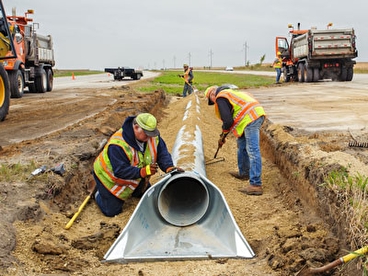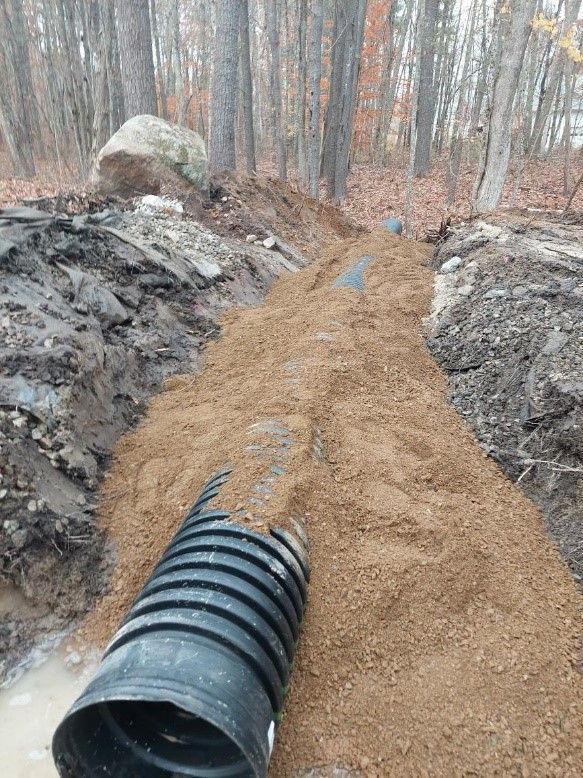Grasping Culvert Installation: Increase Your Land Drainage Efforts
From selecting the best products to carrying out finest techniques, grasping culvert installation can dramatically enhance the performance and longevity of your land drain system. By comprehending the details of culvert setup, you can enhance your drain initiatives and ensure lasting land use practices.
Relevance of Culvert Installment
Guaranteeing correct culvert setup is vital for preserving effective land water drainage systems. Culverts play an essential function in handling water circulation, stopping erosion, and preserving the structural honesty of roads, bridges, and various other facilities. Correct installment of culverts assists to transport water far from roads and structures, lowering the danger of flooding and water damage. Additionally, well-installed culverts help in stopping debris build-up, which can bring about clogs and reduced water flow.
Proper Sizing and Positioning

Proper positioning of culverts is similarly critical. Culverts must be positioned at the least expensive factor of the area calling for drainage to make sure effective water flow. In addition, they must be installed perpendicular to the all-natural slope of the land to avoid obstructions and enable smooth water flow. Strategic placement can aid protect against waterlogging, dirt disintegration, and roadway damage, making certain the durability and efficiency of the land drainage system.
Product Option Tips
Selecting the best materials is paramount in guaranteeing the durability and functionality of culverts for reliable land drain systems. When choosing materials for culvert installment, it is crucial to consider factors such as the water circulation rate, soil structure, and ecological problems of the website.
One of the most common materials utilized for culverts is corrugated metal. Concrete culverts are suitable for locations vulnerable to deterioration or when a longer solution life is preferred.
For environmentally sensitive locations, plastic culverts may be preferred. Furthermore, in areas where all-natural aesthetic appeals are crucial, products like rock or timber can be used to construct culverts that mix effortlessly into the environments.
Installation Techniques and Best Practices
Offered the critical value of material selection in making certain the performance and longevity of culverts, the installation strategies and best techniques play an essential function in the total success of land drainage systems. Appropriate installment is vital to avoid issues such as leakages, falls down, or obstructions that can jeopardize read this post here the efficiency of the culvert.

Throughout setup, care should be required to line up the culvert correctly and provide proper assistance to avoid contortion. Backfilling ought to be done gradually and compacted in layers to stay clear of gaps and negotiation. Appropriate compaction is vital to stop shifting or sinking of the culvert in time.

Maintenance and Long-Term Treatment
Implementing an extensive maintenance plan is essential for guaranteeing the long life and efficient performance of culverts in land drainage systems. Routine inspections need to be carried out to look for any type of indicators of damages, obstructions, or erosion that could jeopardize the functionality of the culvert. Clearing particles such as fallen leaves, branches, and sediment is important to avoid clogging and maintain the flow ability of the culvert. Vegetation control around the culvert location is also important to stop origins from creating architectural damage.
Routine maintenance tasks may include cleansing, fixing joints, reinforcing inlet and electrical outlet structures, and ensuring correct slope and placement of the culvert. Keeping detailed documents of maintenance tasks, evaluations, and repair work is vital for tracking the condition of the culvert over time and planning future upkeep needs.
Conclusion
Finally, grasping culvert setup is important for efficient land drain. Appropriate sizing, positioning, product choice, installation strategies, and upkeep are key elements to think about. By complying with best methods and executing lasting care techniques, landowners can enhance their drainage efforts and ensure the durability and functionality of their culverts. It is vital to focus site web on these aspects to avoid water damage, erosion, and other expensive problems on the residential or commercial property.
Comments on “High Quality Road Construction for Long-Lasting Roads”